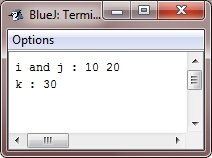- Java Programming Basics
- Java Tutorial
- Java Overview
- Java Environment Setup
- Java Program Structure
- Java Basic Syntax
- Java First Program
- Java Constants
- Java Separators
- Java Keywords
- Java Data Types
- Java Data Types
- Java Integers
- Java Floating Point
- Java Characters
- Java Booleans
- Java Numbers
- Java Programming Variables
- Java Variables
- Java Variable Types
- Java Variable Scope
- Java Type Conversion
- Java Type Casting
- Java Auto Type Promotion
- Java Type Promotion Rules
- Java Programming Arrays
- Java Arrays
- Java One Dimensional Array
- Java Multidimensional Array
- Java Programming Operators
- Java Operators
- Java Arithmetic Operators
- Java Increment Decrement
- Java Bitwise Operators
- Java Left Shift
- Java Right Shift
- Java Relational Operators
- Java Boolean Logical Operators
- Java Ternary(?) Operator
- Java Operator Precedence
- Java Control Statements
- Java Decision Making
- Java if if-else if-else-if
- Java switch Statement
- Java Loops
- Java while Loop
- Java do-while Loop
- Java for Loop
- Java for-each Loop
- Java Nested Loops
- Java break Statement
- Java continue Statement
- Java Class Object Method
- Java Classes and Objects
- Java Class
- Java Object
- Java new Operator
- Java Methods
- Java Constructors
- Java this Keyword
- Java Stack
- Java Overloading Recursion
- Java Method Overloading
- Java Constructor Overloading
- Java Object as Parameter
- Java Call by Value Reference
- Java Returning Objects
- Java Recursion
- Java Modifier Types
- Java Encapsulate Poly String
- Java Encapsulation
- Java Polymorphism
- Java Nested Inner Class
- Java Strings
- Java Command Line Arguments
- Java Variable Length Arguments
- Java Inheritance Abstraction
- Java Inheritance
- Java super Superclass
- Java Multilevel Hierarchy
- Java Method Overriding
- Java Abstraction
- Java Packages Interfaces
- Java Packages
- Java Access Protection
- Java Import Statement
- Java Interfaces
- Java Programming Exceptions
- Java Exception Handling
- Java try catch
- Java throw throws
- Java finally Block
- Java Built In Exceptions
- Java Exception Subclasses
- Java Chained Exceptions
- Java Multithreading
- Java Multithreading
- Java Thread Model
- Java Main Thread
- Java Create Thread
- Java Thread Priorities
- Java Synchronization
- Java Inter Thread Communication
- Java Suspend Resume Stop Thread
- Java Get Thread State
- Java Enum Autobox Annotation
- Java Enumerations
- Java Type Wrappers
- Java Autoboxing
- Java Annotation
- Java Marker Annotations
- Java Single Member Annotation
- Java Built In Annotations
- Java Type Annotations
- Java Repeating Annotations
- Java Data File Handling
- Java Files I/O
- Java Streams
- Java Read Console Input
- Java Write Console Output
- Java PrintWriter Class
- Java Read Write Files
- Java Automatically Close File
- Java Programming Advance
- Java Date and Time
- Java Regular Expressions
- Java Collections Framework
- Java Generics
- Java Data Structures
- Java Network Programming
- Java Serialization
- Java Send Email
- Java Applet Basics
- Java Documentation
- Java Programming Examples
- Java Programming Examples
Java Method Overriding
In a class hierarchy, when method in a subclass having the same name and type signature as method in its superclass, then the method present in subclass is said to override the method in superclass.
When an overridden method is called from inside its subclass, it will always refer to the version of that method defined by the subclass. The version of the method is defined by the superclass will be hidden. Consider the following example:
Java Method Overriding Example
Here is an example demonstrates method overriding in Java:
/* Java Program Example - Java Method Overriding
* This program demonstrates the Method Overriding */
class A
{
int i, j;
A(int x, int y)
{
i = x;
j = y;
}
/* prints the value of i and j */
void display()
{
System.out.println("i and j : " + i + " " + j);
}
}
class B extends A
{
int k;
B(int x, int y, int z)
{
super(x, y);
k = z;
}
/* print k's value, this overrides the display() in A */
void display()
{
System.out.println("k : " + k);
}
}
class JavaProgram
{
public static void main(String args[])
{
B subObj = new B(10, 20, 30);
subObj.display(); // this calls the display() in B
}
}
When the above Java program is compile and executed, it will produce the following output:

When the display() is invoked on an object of the type B, the version of the display() defined within B is used i.e., the version of the display() method inside the B overrides the version declared in the A.
If you wish to access the superclass version of an overridden method, you can do so by using the super. For example, in this version of B, the superclass version of the display() is invoked inside the subclass version. This allows all the instance variables to be displayed.
/* Java Program Example - Java Method Overriding
* This program demonstrates Method Overriding */
class A
{
int i, j;
A(int x, int y)
{
i = x;
j = y;
}
/* print i and j */
void display()
{
System.out.println("i and j : " + i + " " + j);
}
}
class B extends A
{
int k;
B(int x, int y, int z)
{
super(x, y);
k = z;
}
/* print k, this overrides the display() in A */
void display()
{
super.display(); // this calls A's display()
System.out.println("k : " + k);
}
}
class JavaProgram
{
public static void main(String args[])
{
B subObj = new B(10, 20, 30);
subObj.display(); // this calls the display() in B
}
}
When the above Java Program is compile and executed, it will produce the following output:

Here, super.display() calls the superclass version of the display().
Method overriding occurs only when the names and the type signatures of the two methods are same. If they aren't, then the two methods are simply overloaded. For example, consider the following example program which is the modified version of the preceding example :
/* Java Program Example - Java Method Overriding
* Methods with differing type signatures are
* overloaded, not overridden
*/
class A
{
int i, j;
A(int x, int y)
{
i = x;
j = y;
}
/* print i and j */
void display()
{
System.out.println("i and j : " + i + " " + j);
}
}
/* now create a subclass by extending class A */
class B extends A
{
int k;
B(int x, int y, int z)
{
super(x, y);
k = z;
}
/* overload display() */
void display(String msg)
{
System.out.println(msg + k);
}
}
class JavaProgram
{
public static void main(String args[])
{
B subObj = new B(10, 20, 30);
subObj.display("This is k : "); // calls display() in B
subObj.display(); // calls display() in A
}
}
When the above Java program is compile and executed, it will produce the following output:

The version of the display() in B takes a string parameter. This makes its type signature different from the one in A which takes no parameters. Thus, no overriding (or name hiding) takes place. Instead, the version of the display() in B simply overloads the version of the display() in A.
« Previous Tutorial Next Tutorial »